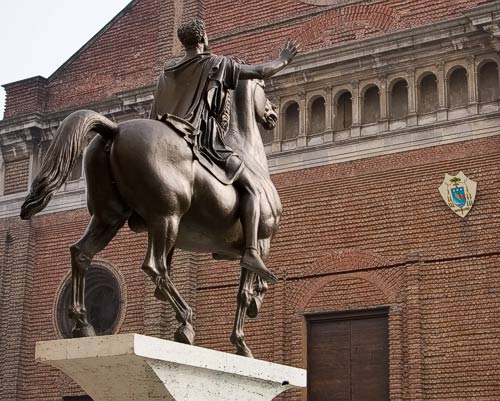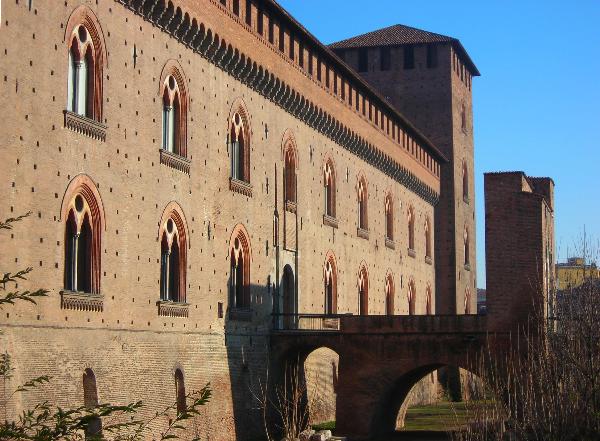Team:UNIPV-Pavia/Pavia/Past
From 2010.igem.org
(New page: __NOTOC__ <table width="100%" border="0"> <tr> <td colspan="3"> {{UNIPV-Pavia/header}} </td> <!-- <td colspan="3" align="center"><html><img src="http://img337.imageshack.us...) |
|||
| Line 13: | Line 13: | ||
<html><p align="center"><font size="4"><b>PAST</b></font></p></html><hr><br> | <html><p align="center"><font size="4"><b>PAST</b></font></p></html><hr><br> | ||
<font size = 4>Pavia</font>, the ancient Ticinum, is a town and comune of south-western Lombardy, northern Italy, 35 km south of Milan on the lower Ticino river near its confluence with the Po. It is the capital of the province of Pavia. It has a population of c. 71,000. The city achieved its greatest political importance between 568 and 774, as the capital of the Kingdom of the Lombards.<br><br> | <font size = 4>Pavia</font>, the ancient Ticinum, is a town and comune of south-western Lombardy, northern Italy, 35 km south of Milan on the lower Ticino river near its confluence with the Po. It is the capital of the province of Pavia. It has a population of c. 71,000. The city achieved its greatest political importance between 568 and 774, as the capital of the Kingdom of the Lombards.<br><br> | ||
| - | Dating back to pre-Roman times, the town of Pavia (then known as Ticinum) was a municipality and an important military site (a castrum) under the Roman Empire. | + | Dating back to <b>pre-Roman times</b>, the town of Pavia (then known as Ticinum) was a municipality and an important military site (a castrum) under the Roman Empire.<br> |
It is said by Pliny the Elder to have been founded by the Laevi and Marici, two Ligurian tribes, while Ptolemy attributes it to the Insubres. | It is said by Pliny the Elder to have been founded by the Laevi and Marici, two Ligurian tribes, while Ptolemy attributes it to the Insubres. | ||
| - | Its importance in Roman times was due to the extension of the Via Aemilia from Ariminum (Rimini) to the Padus (or Po) (187 BC), which it crossed at Placentia (Piacenza) and there forked, one branch going to Mediolanum (Milan) and the other to Ticinum, and thence to Laumellum where it divided once more, one branch going to Vercellae - and thence to Eporedia and Augusta Praetoria - and the other to Valentia - and thence to Augusta Taurinorum (Turin) or to Pollentia. | + | Its importance in <b>Roman times</b> was due to the extension of the Via Aemilia from Ariminum (Rimini) to the Padus (or Po) (187 BC), which it crossed at Placentia (Piacenza) and there forked, one branch going to Mediolanum (Milan) and the other to Ticinum, and thence to Laumellum where it divided once more, one branch going to Vercellae - and thence to Eporedia and Augusta Praetoria - and the other to Valentia - and thence to Augusta Taurinorum (Turin) or to Pollentia.<br> |
| - | Here, in 476, Odoacer defeated Flavius Orestes after a long siege. To punish the city for helping the rival, Odoacer destroyed it completely. However, Orestes was able to escape to Piacenza, where Odoacer followed and killed him, deposing his son Romulus Augustus. This was commonly considered the end of the Western Roman Empire. | + | [[Image:UNIPV_Pavia_regisole-pavia.jpg|thumb|Regisole]] |
| - | A late name of the city in Latin was Papia (probably related to the Pope), which evolved to the Italian name Pavia. Sometimes it's been referred to as Ticinum Papia, combining both Latin names. | + | Here, in 476, Odoacer defeated Flavius Orestes after a long siege. To punish the city for helping the rival, Odoacer destroyed it completely. However, Orestes was able to escape to Piacenza, where Odoacer followed and killed him, deposing his son Romulus Augustus. This was commonly considered the end of the Western Roman Empire.<br> |
| - | Under the Goths, Pavia became a fortified citadel and their last bulwark in the war against Belisarius. | + | A late name of the city in Latin was Papia (probably related to the Pope), which evolved to the Italian name Pavia. Sometimes it's been referred to as Ticinum Papia, combining both Latin names.<br> |
| - | After the Lombards conquest, Pavia became the capital of their kingdom (AD. 568-774). During the Rule of the Dukes, it was ruled by Zaban. It continued to function as the administrative centre of the kingdom, but by the reign of Desiderius, it had deteriorated as a first-rate defensive work and Charlemagne took it in the Siege of Pavia (June, 774) assuming the kingship of the Lombards. Pavia remained the capital of the Italian Kingdom and the centre of royal coronations until the diminution of imperial authority there in the twelfth century. In 1004 Henry II, Holy Roman Emperor bloodily suppressed a revolt of the citizens of Pavia, who disputed his recent crowning as King of Italy. | + | Under the <b>Goths</b>, Pavia became a fortified citadel and their last bulwark in the war against Belisarius. |
| - | In the 12th century Pavia acquired the status of a self-governing commune. In the political division between Guelphs and Ghibellines that characterizes the Italian Middle Ages, Pavia was traditionally Ghibelline, a position that was as much supported by the rivalry with Milan as it was a mark of the defiance of the Emperor that led the Lombard League against the emperor Frederick Barbarossa, who was attempting to reassert long-dormant Imperial influence over Italy. | + | After the Lombards conquest, Pavia became the capital of their kingdom (AD. 568-774). During the Rule of the Dukes, it was ruled by Zaban. It continued to function as the administrative centre of the kingdom, but by the reign of Desiderius, it had deteriorated as a first-rate defensive work and Charlemagne took it in the Siege of Pavia (June, 774) assuming the kingship of the Lombards. Pavia remained the capital of the Italian Kingdom and the centre of royal coronations until the diminution of imperial authority there in the twelfth century. In 1004 Henry II, Holy Roman Emperor bloodily suppressed a revolt of the citizens of Pavia, who disputed his recent crowning as King of Italy.<br> |
| - | In the following centuries Pavia was an important and active town. Under the Treaty of Pavia, Emperor Louis IV granted during his stay in Italy the Palatinate to his brother Duke Rudolph's descendants. Pavia held out against the domination of Milan, finally yielding to the Visconti family, rulers of that city in 1359; under the Visconti Pavia became an intellectual and artistic centre, being the seat from 1361 of the University of Pavia founded around the nucleus of the old school of law, which attracted students from many countries. | + | In the 12th century Pavia acquired the status of a self-governing commune. In the political division between Guelphs and Ghibellines that characterizes the <b>Italian Middle Ages</b>, Pavia was traditionally Ghibelline, a position that was as much supported by the rivalry with Milan as it was a mark of the defiance of the Emperor that led the Lombard League against the emperor Frederick Barbarossa, who was attempting to reassert long-dormant Imperial influence over Italy.<br> |
| - | The Battle of Pavia (1525) marks a watershed in the city's fortunes, since by that time, the former cleavage between the supporters of the Pope and those of the Holy Roman Emperor had shifted to one between a French party (allied with the Pope) and a party supporting the Emperor and King of Spain Charles V. Thus during the Valois-Habsburg Italian Wars, Pavia was naturally on the Imperial (and Spanish) side. The defeat and capture of king Francis I of France during the battle ushered in a period of Spanish occupation which lasted until 1713 at the conclussion of the War of the Spanish Succession. Pavia was then ruled by the Austrians until 1796, when it was occupied by the French army under Napoleon. During this Austrian period the University was greatly supported by Maria Theresa of Austria and saw a great renaissence that eventually lead to a second renaissance due to the presence of leading scientists and humanists like | + | [[Image:UNIPV_Pavia_Castello_Visconteo2.JPG|thumb|Visconti Castle]] |
| - | In 1815, it again passed under Austrian administration until the Second War of Italian Independence (1859) and the unification of Italy one year later. | + | In the following centuries Pavia was an important and active town. Under the Treaty of Pavia, Emperor Louis IV granted during his stay in Italy the Palatinate to his brother Duke Rudolph's descendants. Pavia held out against the domination of Milan, finally yielding to the <b>Visconti family</b>, rulers of that city in 1359; under the Visconti Pavia became an intellectual and artistic centre, being the seat from 1361 of the [[Team:UNIPV-Pavia/Pavia/Athenaeum|University of Pavia]] founded around the nucleus of the old school of law, which attracted students from many countries.<br> |
| + | <b>The Battle of Pavia (1525)</b> marks a watershed in the city's fortunes, since by that time, the former cleavage between the supporters of the Pope and those of the Holy Roman Emperor had shifted to one between a French party (allied with the Pope) and a party supporting the Emperor and King of Spain Charles V. Thus during the <b>Valois-Habsburg Italian Wars</b>, Pavia was naturally on the Imperial (and Spanish) side. The defeat and capture of king Francis I of France during the battle ushered in a period of <b>Spanish occupation</b> which lasted until 1713 at the conclussion of the War of the Spanish Succession. Pavia was then ruled by the <b>Austrians</b> until 1796, when it was occupied by the French army under <b>Napoleon</b>. During this Austrian period the University was greatly supported by Maria Theresa of Austria and saw a great renaissence that eventually lead to a second renaissance due to the presence of leading scientists and humanists like [[Team:UNIPV-Pavia/Pavia/Vip|Alessandro Volta, [[Team:UNIPV-Pavia/Pavia/Vip|Lazzaro Spallanzani]], [[Team:UNIPV-Pavia/Pavia/Vip|Camillo Golgi]] among others.<br> | ||
| + | In 1815, it again passed under Austrian administration until the <b>Second War of Italian Independence (1859)</b> and the <b>unification of Italy</b> one year later. | ||
</td> | </td> | ||
</tr> | </tr> | ||
Revision as of 12:57, 31 July 2010
|
|
|||||||||||||||||||
|
|
|
|||||||||||||||||
 "
"


